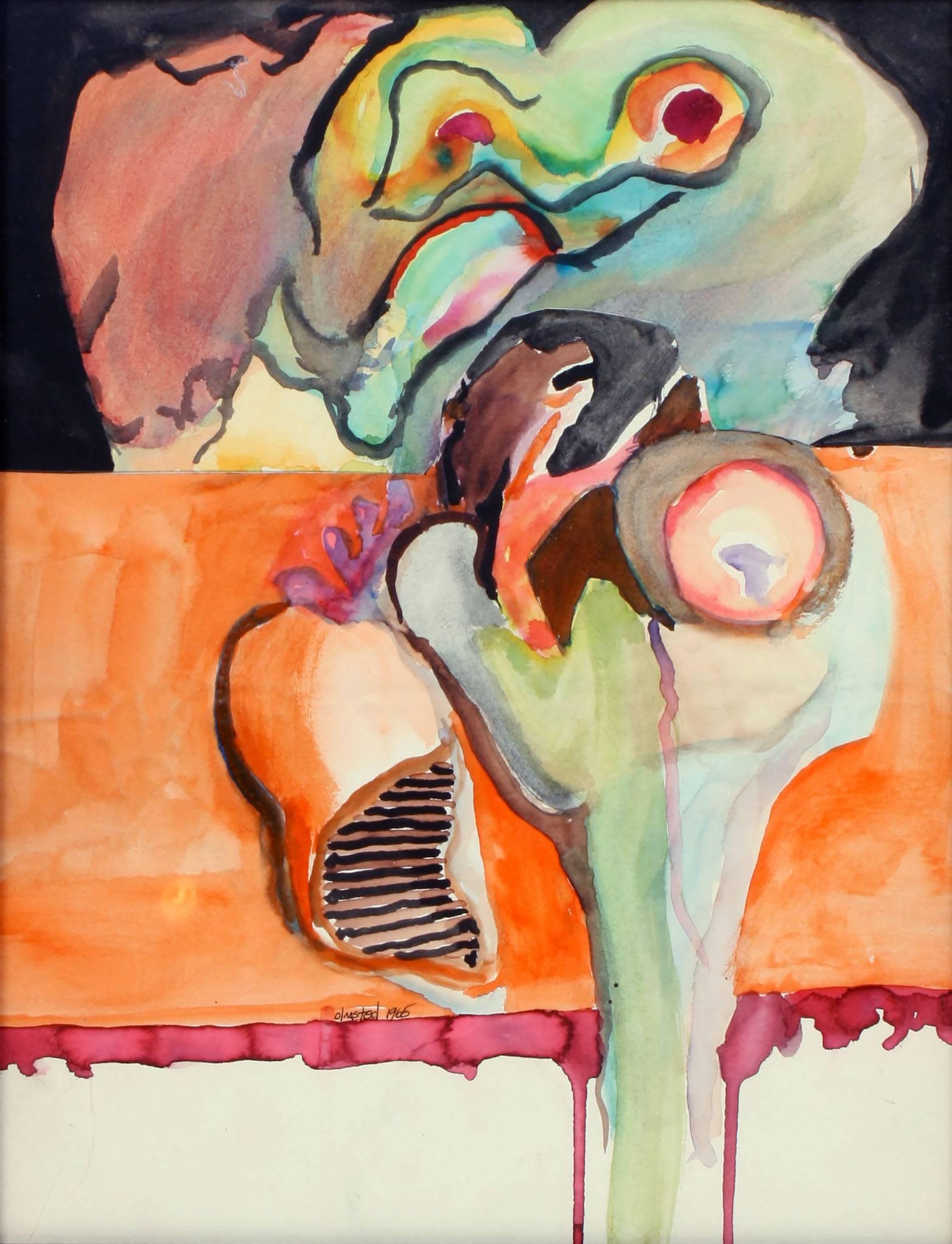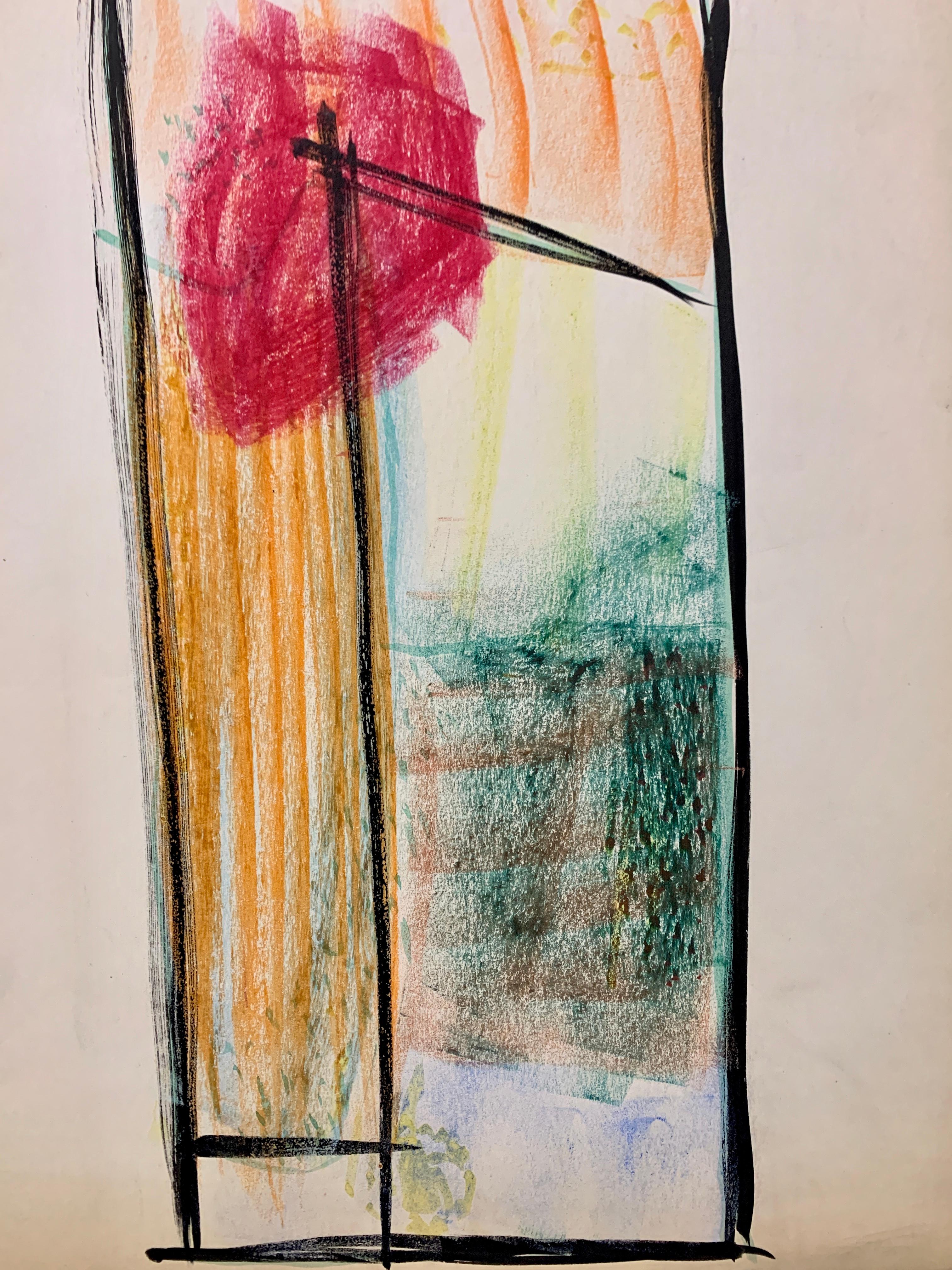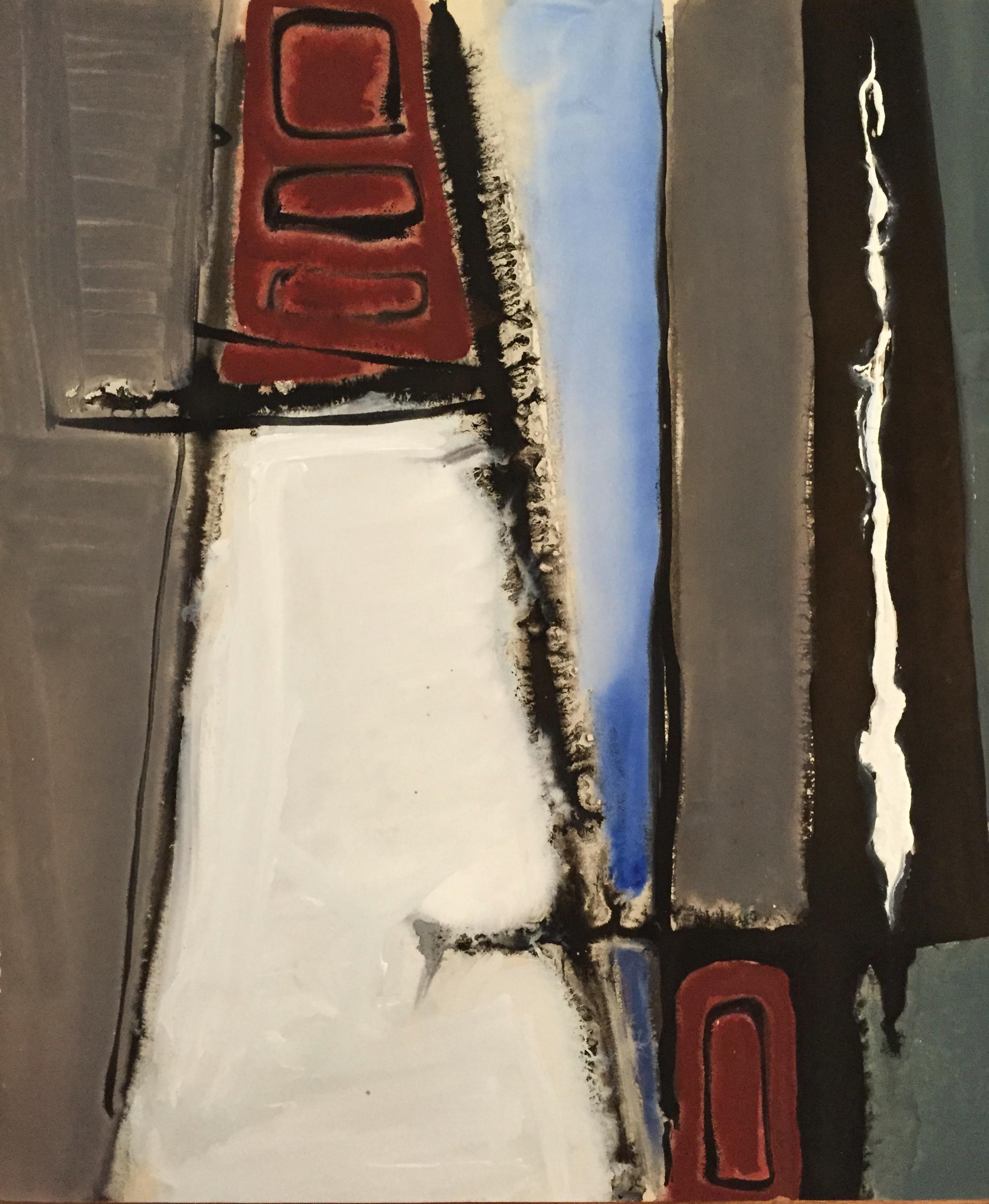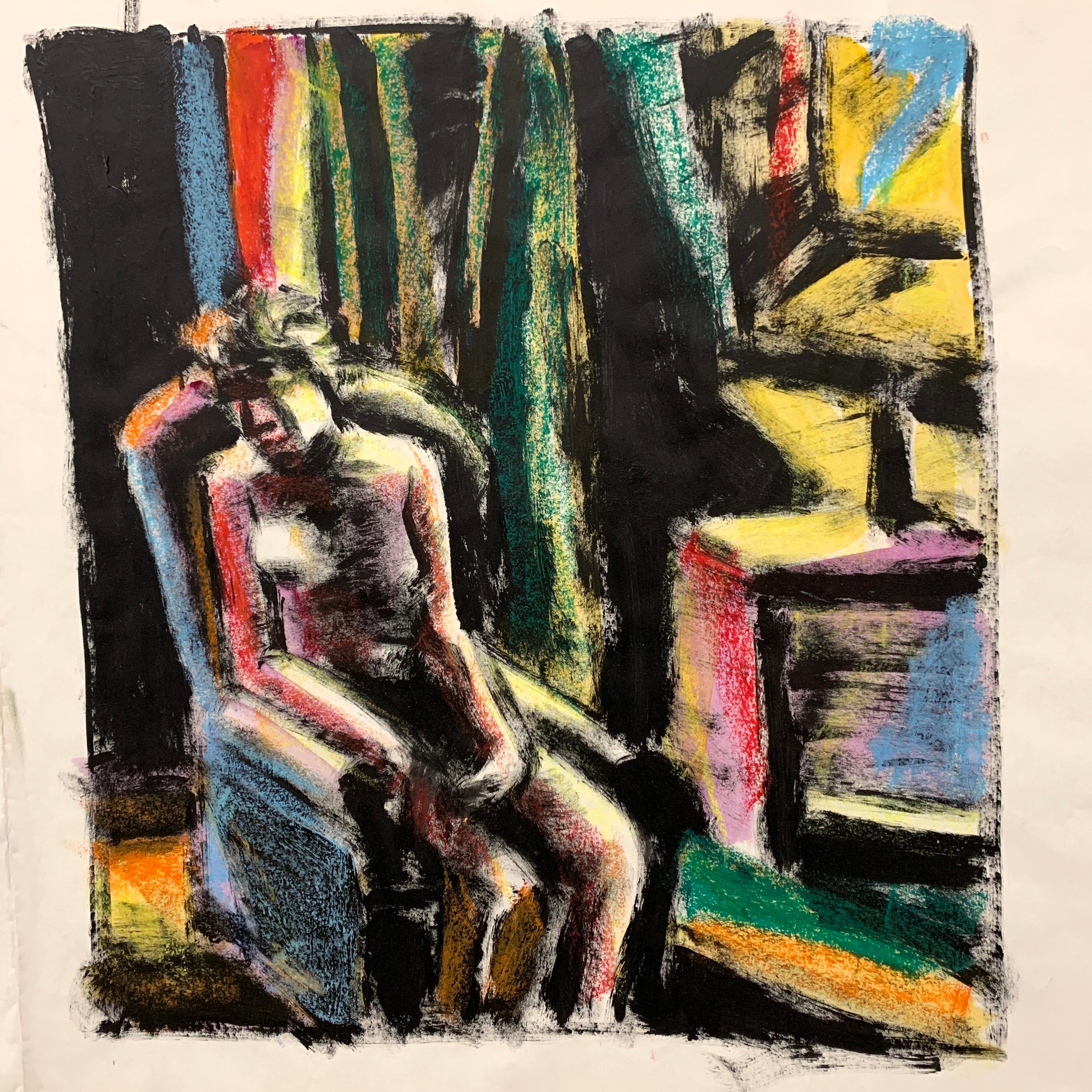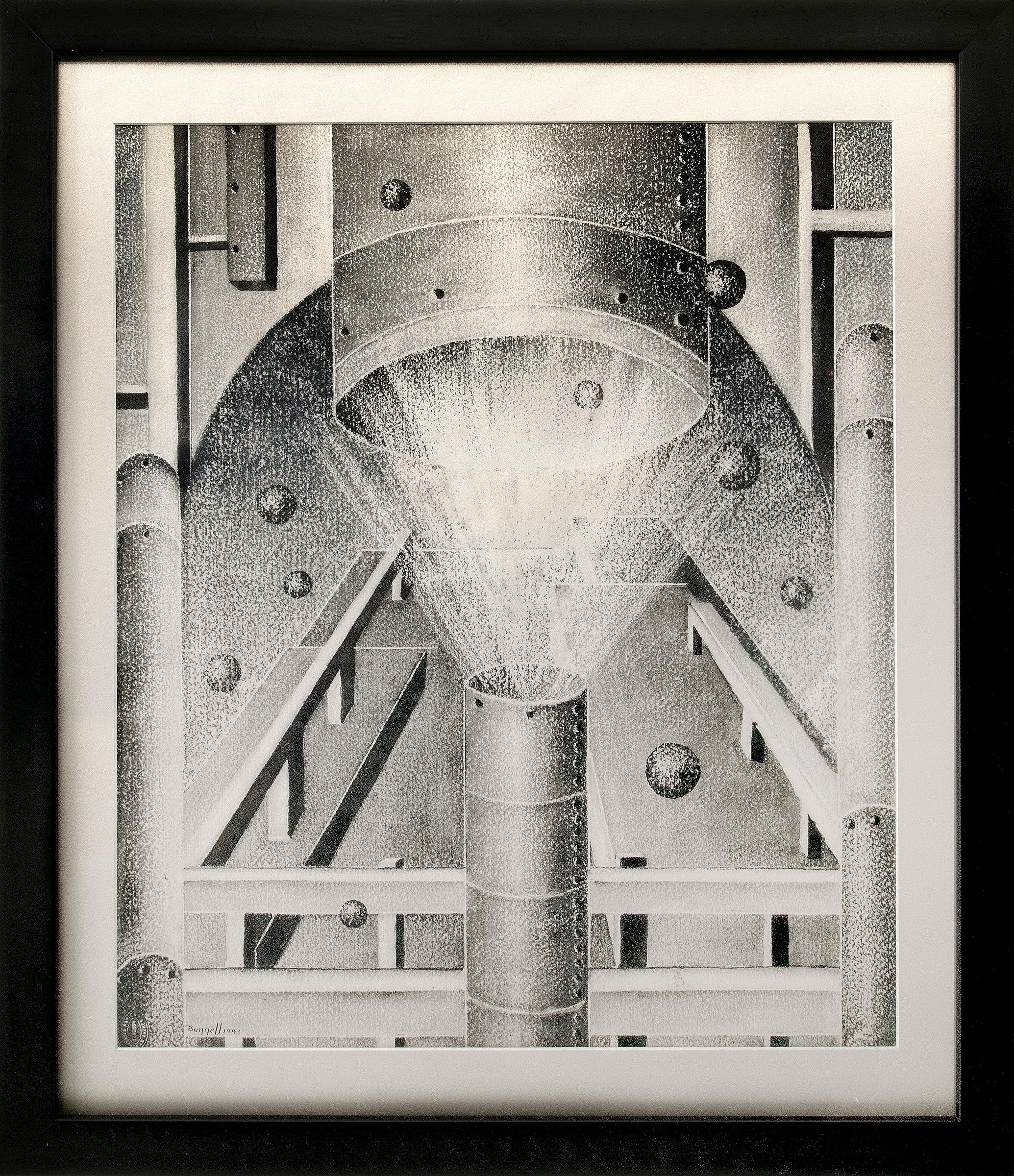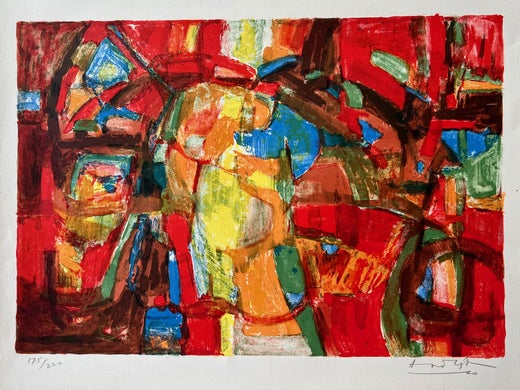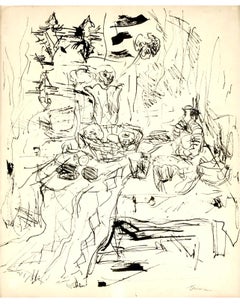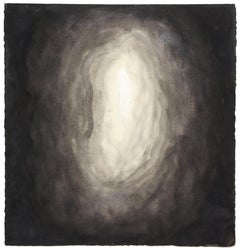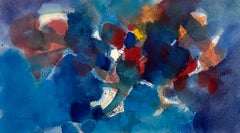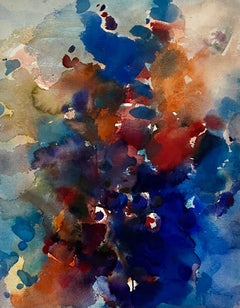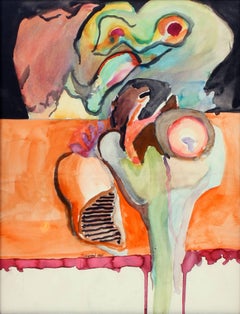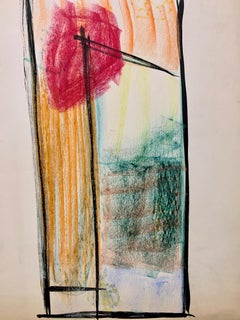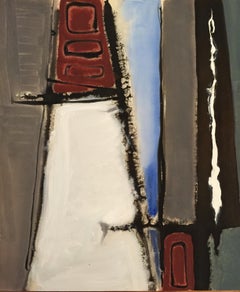Items Similar to Modernist Abstract Expressionist Watercolor Painting Bauhaus Weimar Artist
Want more images or videos?
Request additional images or videos from the seller
1 of 8
Pawel KontnyModernist Abstract Expressionist Watercolor Painting Bauhaus Weimar Artist
About the Item
Abstract watercolor composition bearing the influence of the earlier color-block compositions of Paul Klee.
Pawel August Kontny, (Polish-German-American artist) He was born in Laurahuette, Poland, in 1923, the son of a wealthy pastry shop owner. In 1939 he began studying architecture in Breslau where he was introduced to the European masters and to the work of some of the German Expressionists, soon afterward banned as "degenerate artists" and removed from museums throughout Germany by the Nazi regime. His studies were interrupted by World War II. Drafted into the German army, traveling in many countries as a soldier, he sketched various landscapes but in 1945, he was captured and held as a prisoner of war in Italy. After the war, he studied at the Union of Nuremberg Architects to help design buildings to replace ones destroyed in the war. He recorded his impressions of the local population and the landscapes through his watercolors and drawings. Pawel Kontny thereafter moved to Nuremberg, Germany, becoming a member of the Union of Nuremberg Architects and helping to rebuild the city's historic center. He soon decided to concentrate on his professional art career. He married Irmgard Laurer, a dancer with the Nuremberg Opera. Pavel Kontny 's career as an artist was launched with his participation in an all German exhibition, held at the Dusseldorf Museum in 1952. He held one-man shows in Germany, Switzerland and the United States. During his trip to the United States in 1960, Kontny became instantly enamored with Colorado, and decided to relocate to Cherry Hills with his wife and two children. He quickly established himself in the local art community, being affiliated for a time with Denver Art Galleries and Saks Galleries. His subject matter became the Southwest. During this time he received the Prestigious Gold Medal of the Art Academy of Rome. His extensive travel provided material for the paintings he did using his hallmark marble dust technique. he also worked equally in pastel, watercolor, charcoal and pencil-and-ink. in a style which merged abstraction and realist styles, influenced by Abstract Expressionist painting and South Western American landscapes. In the early 1960s he was one of only a few European-born professional artists in the state, a select group that included Herbert Bayer (1900-1985), a member of the prewar Bauhaus in Weimar and Dessau, Germany, and Roland Detre (1903-2001), a Hungarian modernist painter. As a Denver, Colorado resident, Pavel Kontny exhibited at galleries and museums throughout the United States, Germany and Japan. There, he was inspired by frequent trips to Native American pueblos in the Southwest, as well as by the study of the Plains Indians of Montana and Wyoming. Over the years Kontny had a number of students and generously helped young artist by hosting exhibitions at his Cherry Hills home. For many years he generously donated his paintings to support charitable causes in Denver. Influences during his European years included German pastelist C.O. Muller, German Informel painter Karl Dahmen and Swiss artist, Hans Erni. In the early 1950s his painting style showed the influence of the Die Brücke (The Bridge), a group of German expressionist artists formed in Dresden in 1905 who had a major impact on the evolution of modern art in the twentieth century in Germany. By the middle of the decade his style incorporated more referential abstraction and total abstraction, resulting in part from his study of Hans Hartung, a German artist based in Paris who exhibited his gestural abstract work in Germany. His work also bears the influence of Sam Francis. The American moon landing in 1969 inspired Paul Kontny to create Cosmic, the first of his many abstract compositions of the universe, an oeuvre also figuring prominently in Vance Kirkland’s creative output. He traveled widely as well, visiting the major museums in Germany, France, Spain and England and searching for subject matter in Italy, Yugoslavia, Greece and North Africa. By the time he arrived in Denver, he had an impressive European resumé of affiliations with the Schöninger and Stenzel Galleries in Munich, and shows at galleries and museums in Dusseldorf, Essen, Nuremberg, Frankfurt, Stuttgart, Basel and St. Moritz. The Little Studio and Seidenberg Gallery in New York also had exhibited his work. Paul Kontny 's work is included on various private and corporate collections and museums throughout the United States, Europe and Japan.
- Creator:Pawel Kontny (1923 - 2002, Polish)
- Dimensions:Height: 20 in (50.8 cm)Width: 27 in (68.58 cm)
- Medium:
- Movement & Style:
- Period:
- Condition:
- Gallery Location:Surfside, FL
- Reference Number:1stDibs: LU3829739562
Pawel Kontny
A painter of subjects from many parts of the world, Pawel Kontny began with wartime sketches and changed to a technique combining abstraction and realism. He was born in Laurahuette, Poland, the son of a wealthy pastry shop owner. He studied architecture, but was interrupted by World War II. Traveling in many countries as a soldier, he sketched various landscapes but in 1945, he was captured and held as a prisoner of war in Italy. After the war, he studied at the Union of Nuremberg Architects to help design buildings to replace ones destroyed in the war. He also married Irmgard, a dancer with the Nuremberg Opera Company and began having well received exhibitions of his work throughout Europe. His primary subject became architecture which he built up on heavy weight masonite panels into structures with marble dust. In 1969, the Kotnys moved to Denver, Colorado where he began painting the American West. In February, 1974, "American Artist" magazine had a feature article by John Jellico on Pawel Kontny.
About the Seller
4.9
Platinum Seller
Premium sellers with a 4.7+ rating and 24-hour response times
Established in 1995
1stDibs seller since 2014
1,760 sales on 1stDibs
Typical response time: 1 hour
- ShippingRetrieving quote...Shipping from: Surfside, FL
- Return Policy
Authenticity Guarantee
In the unlikely event there’s an issue with an item’s authenticity, contact us within 1 year for a full refund. DetailsMoney-Back Guarantee
If your item is not as described, is damaged in transit, or does not arrive, contact us within 7 days for a full refund. Details24-Hour Cancellation
You have a 24-hour grace period in which to reconsider your purchase, with no questions asked.Vetted Professional Sellers
Our world-class sellers must adhere to strict standards for service and quality, maintaining the integrity of our listings.Price-Match Guarantee
If you find that a seller listed the same item for a lower price elsewhere, we’ll match it.Trusted Global Delivery
Our best-in-class carrier network provides specialized shipping options worldwide, including custom delivery.More From This Seller
View AllOriginal California Figurative Abstract Still Life Ink Drawing Joyce Treiman
By Joyce Treiman
Located in Surfside, FL
Joyce Treiman
Ink on paper, framed under glass; signed in pencil lower right;
Dimensions: 16 1/2 x 13 3/4 inches; 18 3/4 x 14 3/4 inches frame.
Joyce Wahl Treiman was an American painter, printmaker, sculptor and teacher. Her work ranged from "the impishly perverse and humorously paradoxical to the brilliant and profound." She was known as an excellent draftsperson throughout her career. She made several trips to Europe to study the old masters, and the human figure is central in her work. In her later paintings she is known to have inserted self-portraits. She attended Stephens College in Columbia, Missouri, and then studied at the State University of Iowa (today the University of Iowa) under the influential painter Philip Guston. During World War II she worked as a commercial artist but resigned when she began to have success with exhibitions of her work in Chicago and New York.
In 1945 she married Kenneth Treiman, and son Donald, now an Architect, was born in 1950. The Treimans, along with Rene and Rose Wahl, moved to Los Angeles in 1960. She was in an exhibit of Tamarind prints...
Category
Mid-20th Century American Modern Abstract Paintings
Materials
India Ink, Paper
Abstract Color Field Gradient Painting California Minimalism Shingo Francis
By Shingo Francis
Located in Surfside, FL
Francis, Shingo (Japanese/American, born 1969),
W3 , 1999
Encaustic and watercolor painting on Arches paper,
23.5 x 22.5 inches,
Hand signed and dated verso
Provenance: Garner T...
Category
1990s Abstract Abstract Paintings
Materials
Encaustic, Watercolor, Archival Paper
Modernist Abstract Expressionist Watercolor Painting Bauhaus Weimar Pawel Kontny
By Pawel Kontny
Located in Surfside, FL
Abstract watercolor composition bearing the influence of the earlier color-block compositions of Paul Klee.
Pawel August Kontny, (Polish-German-American artist) He was born in Laurahuette, Poland, in 1923, the son of a wealthy pastry shop owner. In 1939 he began studying architecture in Breslau where he was introduced to the European masters and to the work of some of the German Expressionists, soon afterward banned as "degenerate artists" and removed from museums throughout Germany by the Nazi regime. His studies were interrupted by World War II. Drafted into the German army, traveling in many countries as a soldier, he sketched various landscapes but in 1945, he was captured and held as a prisoner of war in Italy. After the war, he studied at the Union of Nuremberg Architects to help design buildings to replace ones destroyed in the war. He recorded his impressions of the local population and the landscapes through his watercolors and drawings. Pawel Kontny thereafter moved to Nuremberg, Germany, becoming a member of the Union of Nuremberg Architects and helping to rebuild the city's historic center. He soon decided to concentrate on his professional art career. He married Irmgard Laurer, a dancer with the Nuremberg Opera. Pavel Kontny 's career as an artist was launched with his participation in an all German exhibition, held at the Dusseldorf Museum in 1952. He held one-man shows in Germany, Switzerland and the United States. During his trip to the United States in 1960, Kontny became instantly enamored with Colorado, and decided to relocate to Cherry Hills with his wife and two children. He quickly established himself in the local art community, being affiliated for a time with Denver Art Galleries and Saks Galleries. His subject matter became the Southwest. During this time he received the Prestigious Gold Medal of the Art Academy of Rome. His extensive travel provided material for the paintings he did using his hallmark marble dust technique. he also worked equally in pastel, watercolor, charcoal and pencil-and-ink. in a style which merged abstraction and realist styles, influenced by Abstract Expressionist painting and South Western American landscapes. This one is influenced by California Abstract Expressionist artist Sam Francis. In the early 1960s he was one of only a few European-born professional artists in the state, a select group that included Herbert Bayer (1900-1985), a member of the prewar Bauhaus in Weimar and Dessau, Germany, and Roland Detre (1903-2001), a Hungarian modernist painter. As a Denver, Colorado resident, Pavel Kontny exhibited at galleries and museums throughout the United States, Germany and Japan. There, he was inspired by frequent trips to Native American pueblos in the Southwest, as well as by the study of the Plains Indians of Montana and Wyoming. Over the years Kontny had a number of students and generously helped young artist by hosting exhibitions at his Cherry Hills home. For many years he generously donated his paintings to support charitable causes in Denver. Influences during his European years included German pastelist C.O. Muller, German Informel painter Karl Dahmen and Swiss artist, Hans Erni. In the early 1950s his painting style showed the influence of the Die Brücke (The Bridge), a group of German expressionist artists formed in Dresden in 1905 who had a major impact on the evolution of modern art in the twentieth century in Germany. By the middle of the decade his style incorporated more referential abstraction and total abstraction, resulting in part from his study of Hans Hartung, a German artist based in Paris who exhibited his gestural abstract work in Germany. The American moon landing in 1969 inspired Paul Kontny...
Category
20th Century Abstract Expressionist Abstract Drawings and Watercolors
Materials
Watercolor, Archival Paper
Modernist Abstract Expressionist Watercolor Painting Bauhaus Weimar Artist
By Pawel Kontny
Located in Surfside, FL
Abstract watercolor composition bearing the influence of the earlier color-block compositions of Paul Klee and Abstract Expressionist master Sam Francis.
Pawel August Kontny, (Polish-German-American artist) He was born in Laurahuette, Poland, in 1923, the son of a wealthy pastry shop owner. In 1939 he began studying architecture in Breslau where he was introduced to the European masters and to the work of some of the German Expressionists, soon afterward banned as "degenerate artists" and removed from museums throughout Germany by the Nazi regime. His studies were interrupted by World War II. Drafted into the German army, traveling in many countries as a soldier, he sketched various landscapes but in 1945, he was captured and held as a prisoner of war in Italy. After the war, he studied at the Union of Nuremberg Architects to help design buildings to replace ones destroyed in the war. He recorded his impressions of the local population and the landscapes through his watercolors and drawings. Pawel Kontny thereafter moved to Nuremberg, Germany, becoming a member of the Union of Nuremberg Architects and helping to rebuild the city's historic center. He soon decided to concentrate on his professional art career. He married Irmgard Laurer, a dancer with the Nuremberg Opera. Pavel Kontny 's career as an artist was launched with his participation in an all German exhibition, held at the Dusseldorf Museum in 1952. He held one-man shows in Germany, Switzerland and the United States. During his trip to the United States in 1960, Kontny became instantly enamored with Colorado, and decided to relocate to Cherry Hills with his wife and two children. He quickly established himself in the local art community, being affiliated for a time with Denver Art Galleries and Saks Galleries. His subject matter became the Southwest. During this time he received the Prestigious Gold Medal of the Art Academy of Rome. His extensive travel provided material for the paintings he did using his hallmark marble dust technique. he also worked equally in pastel, watercolor, charcoal and pencil-and-ink. in a style which merged abstraction and realist styles, influenced by Abstract Expressionist painting and South Western American landscapes. In the early 1960s he was one of only a few European-born professional artists in the state, a select group that included Herbert Bayer (1900-1985), a member of the prewar Bauhaus in Weimar and Dessau, Germany, and Roland Detre (1903-2001), a Hungarian modernist painter. As a Denver, Colorado resident, Pavel Kontny exhibited at galleries and museums throughout the United States, Germany and Japan. There, he was inspired by frequent trips to Native American pueblos in the Southwest, as well as by the study of the Plains Indians of Montana and Wyoming. Over the years Kontny had a number of students and generously helped young artist by hosting exhibitions at his Cherry Hills home. For many years he generously donated his paintings to support charitable causes in Denver. Influences during his European years included German pastelist C.O. Muller, German Informel painter Karl Dahmen and Swiss artist, Hans Erni. In the early 1950s his painting style showed the influence of the Die Brücke (The Bridge), a group of German expressionist artists formed in Dresden in 1905 who had a major impact on the evolution of modern art in the twentieth century in Germany. By the middle of the decade his style incorporated more referential abstraction and total abstraction, resulting in part from his study of Hans Hartung, a German artist based in Paris who exhibited his gestural abstract work in Germany. The American moon landing in 1969 inspired Paul Kontny...
Category
20th Century Abstract Expressionist Abstract Drawings and Watercolors
Materials
Watercolor, Archival Paper
Large Abstract Expressionist Watercolor Color Field Painting Paul Jenkins Style
By Dom Mingolla
Located in Surfside, FL
Dominic Mingolla (1922 – 1999) Mingolla created paintings in many different materials and genres. Best known for his large abstract expressionist watercolor paintings similar in style to Paul Jenkins and for his Enamel work. His work bears affinities both to Lyrical Abstraction and to Tachisme artists such as Nicolas de Staël, Serge Poliakoff, Andre Lanskoy, Hans Hartung, Jean-Paul Riopelle, Gustave Singier, Alfred Manessier, Roger Bissiere, "Lyrical Abstraction arose in the 1960s and 70s, following the challenge of Minimalism and Conceptual art. Many artists began moving away from geometric, hard-edge, and minimal styles, toward more lyrical, sensuous, romantic abstractions worked in a loose gestural style. These "lyrical abstractionists" sought to expand the boundaries of abstract painting, and to revive and reinvigorate a painterly 'tradition' in American art. At the same time, these artists sought to reinstate the primacy of line and color as formal elements in works composed according to aesthetic principles – rather than as the visual representation of sociopolitical realities or philosophical theories." "Characterized by intuitive and loose paint handling, spontaneous expression, illusionist space, acrylic staining, process, occasional imagery, and other painterly techniques, the abstract works included in this exhibition sing with rich fluid color and quiet energy. Artists associated with Lyrical Abstraction include: Natvar Bhavsar, Lamar Briggs, Friedel Dzubas, Sam Francis, Ronnie Landfield, Pat Lipsky...
Category
20th Century Abstract Abstract Drawings and Watercolors
Materials
Watercolor, Archival Paper
Large Abstract Expressionist Watercolor Color Field Painting Paul Jenkins Style
By Dom Mingolla
Located in Surfside, FL
Dominic Mingolla (1922 – 1999) Mingolla created paintings in many different materials and genres. Best known for his large abstract expressionist watercolor paintings similar in style to Paul Jenkins and for his Enamel work. His work bears affinities both to Lyrical Abstraction and to Tachisme artists such as Nicolas de Staël, Serge Poliakoff, Andre Lanskoy, Hans Hartung, Jean-Paul Riopelle, Gustave Singier, Alfred Manessier, Roger Bissiere, "Lyrical Abstraction arose in the 1960s and 70s, following the challenge of Minimalism and Conceptual art. Many artists began moving away from geometric, hard-edge, and minimal styles, toward more lyrical, sensuous, romantic abstractions worked in a loose gestural style. These "lyrical abstractionists" sought to expand the boundaries of abstract painting, and to revive and reinvigorate a painterly 'tradition' in American art. At the same time, these artists sought to reinstate the primacy of line and color as formal elements in works composed according to aesthetic principles – rather than as the visual representation of sociopolitical realities or philosophical theories." "Characterized by intuitive and loose paint handling, spontaneous expression, illusionist space, acrylic staining, process, occasional imagery, and other painterly techniques, the abstract works included in this exhibition sing with rich fluid color and quiet energy. Artists associated with Lyrical Abstraction include: Natvar Bhavsar, Lamar Briggs, Friedel Dzubas, Sam Francis, Ronnie Landfield, Pat Lipsky...
Category
20th Century Abstract Abstract Drawings and Watercolors
Materials
Watercolor, Archival Paper
You May Also Like
Abstract Landscape
By Wes Olmsted
Located in Buffalo, NY
An original watercolor painting by American artist Wes Olmsted depicting an abstract landscape view.
Category
1960s American Modern Abstract Paintings
Materials
Archival Paper, Watercolor
1950s "Red Sun" Mid Century Abstract Art Students League NYC
By Donald Stacy
Located in Arp, TX
Donald Stacy
"Red Sun"
c.1950s
Gouache and oil pastel on paper
13.75" x 17" unframed
Unsigned
Came from artist's estate
*Custom framing available for additional charge. Please expect framing time between 3-5 weeks.
Donald Stacy (1925-2008) New Jersey
Studied: Newark School of Fine Art
The Art Students League...
Category
Mid-20th Century American Modern Abstract Drawings and Watercolors
Materials
Paper, Oil Pastel, Gouache
1950s "Rectangle" Mid Century Abstract Gouache Painting
Located in Arp, TX
Opper Estate
Maroon Abstract
c. 1940-1950's
Gouache on Paper
15" x 18" Unframed
From the estate of Ruth Friedmann Opper & Jerry Opper. Ruth was the daughter of Bauhaus artist, Gustav Friedmann.
San Francisco Abstract Expression
A free-spirited wave of creative energy swept through the San Francisco art community after World War II. Challenging accepted modes of painting, Abstract Expressionists produced highly experimental works that jolted the public out of its postwar complacency.
Abstract Expressionism resulted from a broad collective impulse rather than the inspiration of a small band of New York artists. Documenting the interchanges between the East and West Coasts, she cites areas of mutual influence and shows the impact of San Francisco on the New York School, including artists such as Mark Rothko and Ad Reinhardt. San Francisco's Beat poets...
Category
Mid-20th Century American Modern Abstract Paintings
Materials
Paper, Gouache
Abstract Work on Paper Mid-Century Modernism Greek American Gouache Drawing
By Jean Xceron
Located in New York, NY
Abstract Work on Paper Mid-Century Modernism Greek American Gouache Drawing.
A modernist artist who emigrated to America from Greece in 1904, when he was fourteen years old, Jean Xceron is described as having a reputation as an artist that has mysteriously fallen into obscurity---especially since he was reportedly quite prominent during his lifetime. However, a partial explanation of that omission is the fact that many of his papers and early records have been lost. He was a painter of biomorphic abstractions and did collages, which were influenced by Dadaism.
Xceron was active in New York City when modernism was gaining influence. Of him during this period, it was written that his artistic role was "a vital link between what is commonly termed as the first-generation (the Stieglitz group, the Synchromists, etc.) and second-generation, the American Abstract Artists, the Transcendental Painting...
Category
1940s American Modern Abstract Drawings and Watercolors
Materials
Paper, Gouache
1950s "Sitting in Chair" Mid Century Figurative Pratt Graphic Arts Center
By Donald Stacy
Located in Arp, TX
Donald Stacy
"Sitting in Chair"
c.1950s
Gouache and oil pastel on paper
24" x 18" unframed
Came from artist's estate
*Custom framing available for additio...
Category
Mid-20th Century American Modern Abstract Drawings and Watercolors
Materials
Paper, Oil Pastel, Gouache
1940s American Modernist Abstract Industrial Watercolor Ink Charcoal Painting
By Charles Ragland Bunnell
Located in Denver, CO
This original vintage painting by Charles Ragland Bunnell (1897-1968), titled Quitting Time from Bunnell's Black and Blue Series from 1941, exemplifies his unique Abstract Structure ...
Category
1940s American Modern Abstract Drawings and Watercolors
Materials
Charcoal, Ink, Watercolor
Recently Viewed
View AllMore Ways To Browse
Swiss 20th Century Artists
African And Painting And South Africa
Art Western Watercolor
New England Watercolor
Bauhaus Painting
Pencil Modernist
Soldier And War Painting
Yugoslavia Artists
Mid Century Modern Japanese Paintings
Spanish Artists 20th C
Montana Artist
Weimar Art
Weimar Germany
Dancer Figure Drawing
Figure Dance Drawing
C Hans Paintings
Watercolor Landscapes Colorado
Germany Painting 1905
